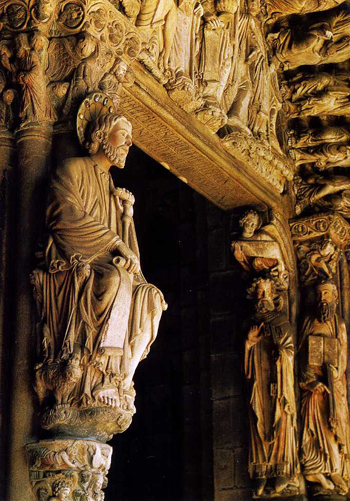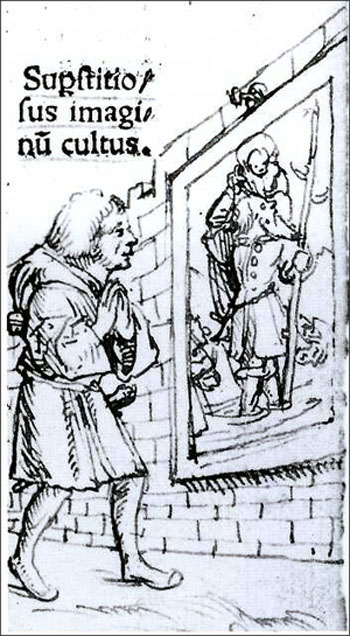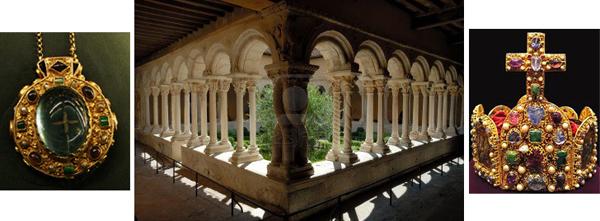 |
Book Reviews
The Middle Ages on the Coffee Table
Patrick Odou
Book review of Medieval Panorama, ed. by Robert Bartlett,
London: Thomas & Hudson Ltd, 2001, 336 pp.
"There was a time when the philosophy of the Gospel governed the States. In that epoch, the influence of Christian wisdom and its divine virtue penetrated the laws, institutions, and customs of the people, all the categories and all the relations of civil society.
"Then the Religion instituted by Jesus Christ, solidly established in the degree of dignity due to it, flourished everywhere, thanks to the favor of Princes and the legitimate protection of the Magistrates. Then the Priesthood and the Empire were united by a happy concord and by the friendly interchange of good offices. So organized, civil society gave fruits superior to all expectations, whose memory subsists and will subsist, registered as it is in innumerable documents that no artifice of the adversaries can destroy or obscure.” (1)
This inspiring paragraph by Pope Leo XIII in his Encyclical Immortale Dei should remind Catholic counter-revolutionaries to proudly display these “fruits superior to all expectations” on every possible occasion. In one’s home or at the office, using photos, statues, paintings, symbols and many other methods I believe it is an act of apostolate to present these medieval marvels and allow others, with the help of divine grace, to admire the fruits of Christendom.
One method that is somewhat economical for this purpose is the use of coffee table books - large photo albums placed in the center of your living room that present the beauty and splendor of the Middle Ages. There are countless books of this nature. Some are photo albums of medieval armor, others of stain-glass windows, tapestries, cathedrals, castles, etc.
I recently encountered one such coffee table photo album entitled Medieval Panorama, edited by Robert Bartlett. The photos are beautiful, the presentation is clear, and as such it is sufficient to display the magnificence of this Age of the Gospel despite the “artifice of the adversaries,” which can be seen in the secular text. Like almost all mainstream books about the Middle Ages, this book is fundamentally secular in its approach.

Detail of the Portal of Glory, the 13th century entrance portal to Santiago de Compostela |
But I did find something written in this photo album that I believe is worthwhile for our readers to consider. Bartlett presents a simple but good explanation of the early days of what we call the Revolution, and how the term Middle Ages came about.
“Of course no one in the Middle Ages knew they were living in the Middle Ages. The term is a retrospective label, applied by subsequent generations who felt they had emerged from that ‘middle’ period to a new one. The condescending tag was first used by the humanist scholars of the Renaissance, who believed that they shared common cultural assumptions not with their medieval predecessors but with the educated patricians of ancient Rome.
"Hence, their threefold periodization of history; the ancient world, the Middle Ages, themselves. It was not long before these humanists were using another self-congratulatory term for their own period: it was the age of ‘rebirth’ – Renaissance.” (2)
In other words, this “time when the philosophy of the Gospel governed the States” as Leo XIII adroitly puts it, was given the name Middle Ages retrospectively by humanists and the men of the Renaissance – early agents of the Revolution. They created this condescending tag as a sign of their own rejection of and separation from that time where “Christian wisdom and its divine virtue penetrated the laws, institutions, and customs of the people, all the categories and all the relations of civil society.”
And just as the philosophy of the Gospel penetrated into every aspect of human life, so did this opposite spirit of the Revolution permeate everyday life. The obsession to reject all things regarding Church and Christian Civilization exploded into every pursuit of man, Bartlett explains:
“Italian scholars of the 14th and 15th centuries focused more intensely than ever before upon the literature of pagan Rome and Greece, sought out lost texts, changed their handwriting to imitate what they thought was classical script, produced buildings, sculptures and paintings in a classical style. In doing so they also created the [expression] Middle Ages – everything that lay between the classicism of ancient Rome and that of their own day."
That is to say, they considered the pagan ancient world the first age of culture, and the Renaissance was a reawakening of that supposedly great civilization. What came in-between was a “middle period,” a “dark age.”
Bartlett, an awarded mainstream medieval historian, also clearly states that this anti-Catholic bias (of course, in his secular approach, he doesn’t dare call it such) “managed to capture the central institutions of higher education” all the way up to and including the present day.
“Naturally, a term that was invented as part of a conscious ideological campaign to foster one cultural style and decry another cannot be regarded as a neutral term of historical analysis. ‘The Middle Ages’ thus belongs to the group of historical labels like ‘Dark Ages’, ‘Reformation’ and ‘Enlightenment’ which were invented to express approval or disapproval rather than attempt description. One of the reasons the phrase ‘Middle Ages’ stuck was that the humanists did not fade away as a passing cultural fad of the 14th and 15th centuries but managed to capture the central institutions of higher education and make their programme the core of elite culture down to the 20th century – hence its strong classical bias.”

A Holbein drawing for Erasmas' Praise of Folly shows a fool praying before St. Christopher |
Bartlett then goes on to explain that this attack against Christendom by Humanism and the Renaissance was further exploited by the Protestants “who came fast upon their heels.” “The picture that the Renaissance humanists created of their medieval predecessors – men enmired in crude Latin and logic-chopping – was both reinforced and redrawn by the Protestant reformers who came fast upon their heels. Protestants agreed with humanists that there had been a golden age, although for them it was the time of the primitive Church rather than the heyday of classical Latin literature, and they also saw the thousand years before their own time as a trough or depression from which they wished to climb.
“For them, however, it was the tyranny of popes, bishops and monks that they aimed to end, along with their ‘superstitions’ – reverence for saints and relics, belief in Purgatory, prayers for the dead, the paraphernalia of a celibate priestcraft. The medieval period was regarded not only as an age of barbarous Latin and clumsy art but also as a time of papistry and credulous beliefs.”
So, we see that Humanism, the Renaissance, and Protestantism came out from the different corners of the arena to unite, despite their differences, and do battle against the Catholic Church and Christendom. “And Herod and Pilate were made friends, that same day; for before they were enemies one to another.” (Lk. 23:12)
I wanted to share this reading with TIA readers to remind them that today’s History is not so objective, as is often claimed, but that the proofs of the battle between the Revolution and the Counter-Revolution can be found even in mainstream coffee table books.

From left to right, Charlemagne's personal reliquary with a fragment of the True Cross, 12th century cloiseter of Aix-en-Provence in southern France, 10th century imperial crown |
1. Leo XIII, Encyclical, Immortale Dei of November 1, 1885 Paris: Bonne Press, vol 2, p. 39.
2. Robert Bartlett, Medieval Panorama . Los Angeles: Paul Getty Museum, 2001 Thames & London: Hudson Ltd,. pp. 9-10

Posted March 6, 2013

Related Topics of Interest
 The Middle Ages, a Forest Filled with Symbols The Middle Ages, a Forest Filled with Symbols
 Refuting anti-Catholic Lies about the Middle Ages Refuting anti-Catholic Lies about the Middle Ages
 A World of Brilliant Colors A World of Brilliant Colors
 Medieval Work & Leisure Medieval Work & Leisure
 Women in the Middle Ages Women in the Middle Ages
 The Rich Medieval Menu The Rich Medieval Menu

Related Works of Interest
|
|
Book Reviews | Home | Books | CDs | Search | Contact Us | Donate

© 2002-
Tradition in Action, Inc. All Rights Reserved
|
 |

|